Berlin, March 2010
by JANET McKENZIE
The work in his studio show is work in progress towards a major exhibition Blood Aquarium, to be shown at The Station Museum of Contemporary Art in Houston, Texas in January 2011.1 All of his work addresses the futility and madness of war with a searing power and urgency. The year in Berlin has enabled Gittoes to make significant progress on a body of work that he has been working towards whilst making film footage in Iraq and Afghanistan. Berlin, he explains, has enabled him to put ideas in to practice that have been developing for some years.
57.5x72.5cm-b.jpg)
George Gittoes. The Riddle 11, 2002. Drawing: pencil and mixed media on paper, 57.5 cm x 72.5 cm. Collection of Artist.
Australian-born George Gittoes (b1949) studied in Sydney and New York before returning to Sydney to establish The Yellow House, an experimental cooperative with Martin Sharp and Brett Whiteley. He has travelled almost continuously now, since the 1970s, committed to the humanitarian disasters that have taken place in war zones, around the world. Rejecting the label of war artist, Gittoes does not understand why more artists do not leave the studio for war zones, considering that “the role of artists is to heal people, like shamans. We have a role on the front line. It is important to create in the face of destruction and to let people know that you care and to be there, with them …. Once you are involved you get beyond fear”.2 It is through drawing that his most poignant images are made due to his skill as a draughtsman and because they have the authenticity that comes from working in situ in almost every war zone since Vietnam: Cambodia, Nicaragua, Philippines, Somalia, South Africa, Rwanda, Mozambique, Western Sahara, Southern Lebanon, Palestine-Israel, Tibet, East Timor, Bougainville, Northern Ireland, Congo, Yemen, Iraq, North Western Frontier of Pakistan, Afghanistan.
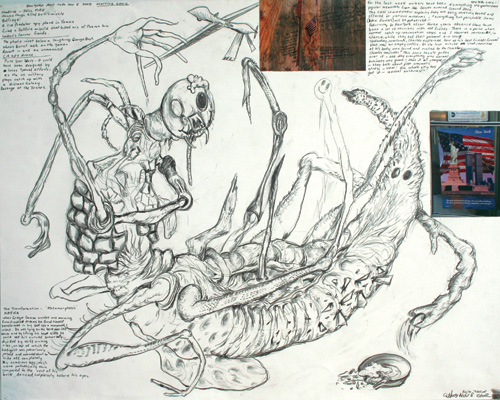
George Gittoes. The transformation - Metamorphosis - Kafka NY, 8 November 2002. Pencil and mixed media, 58.5 x 72.5 cm.
In Germany Gittoes has long perceived the legacy of inherited guilt, making it an appropriate place to confront current global issues of war and terrorism in the 21st century. For German artists since the Second World War, the legacy of Hitler’s atrocities cast the darkest of shadows. Both culturally and physically Germany was in a state of abject despair. Artistic manifestations have been many and varied; Anselm Kiefer’s poignant work over the past 30 years signifies the challenge for his generation. “There is always hope, but that must be combined with irony and, more important, scepticism.”3 A vision of heaven in today’s world Kiefer believes can only be achieved if the full weight of history is acknowledged. “I am not trying to illustrate religion”, Kiefer has stated, “I’m a storyteller with a broken history.”4
Kiefer has sought to define art’s role and the role of the artist in a traumatised post-war world. He incorporates a traditional palette as a symbol to imply the aspiration of art to seek a higher plane. In the early 1980s an image of a palette hovers precariously between the physical landscape and the starry heavens. In certain paintings the palette lies on the messy floor among the detritus of life; in others it hovers over the physical desolation of Hitler’s war. “In his desperate attempt to communicate beyond the halls of philosophy, church, and state, an artist invariably finds himself in a kind of purgatory.”5
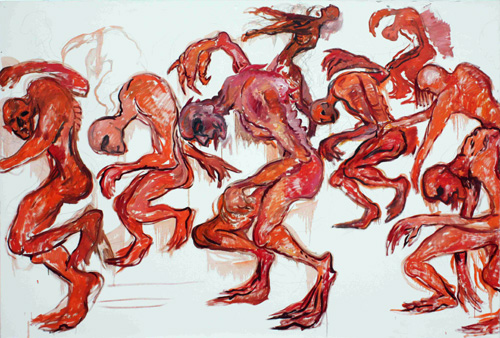
George Gittoes. Zombie Shuffle, 2009–2010. Oil on canvas, 200 cm x 300 cm.
Pre- and post-war Germany and East Germany and West Germany represented the divided national psyche. The Fracture paintings of Georg Baselitz represent the violent ruptures and break from historical continuity; they reveal the distress and destruction of Germany’s history. When the Allied Forces bombed Dresden in 1945, the young Baselitz witnessed the horrors. One can be forgiven for having a love/hate relationship with the work of one of Germany’s most uncompromising artists, whose self-advertisement and self-aggrandisement exist in parallel with poignant, albeit extraordinarily ugly, images. Every work in Baselitz’s show refers to war, whether it is the black mood, fractured presence or specific references. Baselitz tackles the overwhelming problem of being German and being loathed, with a combination of urgency and insolence. His work presents images of a world possessed, a dreadful fracturing of human values, the collapse of civilisation itself. He distorts the human form and in doing so, creates works that are physically disgusting. The paint is applied as excrement, pushed and shoved around the canvas with apparent contempt. The derision is in Baselitz’s scheme of things, a comment on human nature itself, a comment on war whether it is Vietnam or Iraq. In his view human nature has not changed. It was individuals carrying the guilt of their Nazi forebears that Gittoes believed would make an appropriate audience initially for his Descendence series. Where Gittoes departs from Kiefer and Baselitz is the global context for dialogue. His is not personal guilt or that of his nation, but a global phenomenon, based in non-Western war zones, where complex issues in relation to the West exist, most recently Iraq and Afghanistan. The futility of war as subject, links him to the German tradition, but the daring required to enter territory where most Westerners do not venture, marks his departure and his originality. He explains:
For the last few years I have been making drawings and observations in my diary notebooks about how I see war as horror and the internal damage it does as being more enduring than the physically destroyed buildings and bodies. I have visited Germany many times between conflicts such as Bosnia and Rwanda and Iraq and have always felt the atmosphere here was not such a huge leap from that of the war I had just left. All the Germans I had come close to still seemed to be hurting from the inner damage, regret and guilt left over from WWII and the Holocaust.
I realized I needed a year to bring all the ideas and drawings from the diaries into a coherent series of images through studio paintings and felt Berlin was the appropriate place to do it. This work is about the damage that is done to the soul of both the individual and a country by war – I chose Germany to be the place to produce my Descendence series, paintings and stories.6
When Gittoes was travelling back from Bosnia in 1995 he went to a Käthe Kollwitz exhibition in Berlin, where Max Beckmann’s (1884–1950) granddaughter, Mayen Beckmann was the curator. In conversation he showed her his portfolio. She asked Gittoes if he kept a diary. “All the drawings”, she recalled, “looked spontaneous, but perfect and all had notes and stories in their margins. He told me he always carried either paper in a black zip folder with a wooden board inside and paper clips or drawing pins, or a large, black, bound sketchbook/diary. He said he sketched wherever he found time and opportunity: at the side of a tank, in the quiet of his room or in the seat of an airplane. Looking at his work I had the feeling of sitting on his shoulders and living through the horror with him. He crams what he experiences over a period of time into his drawings with nervous short lines flying from his hands onto the paper. Thus his drawings become multi-layered impressions accompanied by notes, portraits of terribly wounded victims mixed in with text (from his experiences, from dreams and from his observations), photos, found pictures and everything relevant he sees and finds and saves.”7 Thus began Mayen Beckmann’s dialogue with Gittoes in 1995, “about the artist as witness, about the power of drawing that is stronger than photography or film”. Her recent essay where she appraises Gittoes work in direct relation to the German Expressionist movement begins with a statement by Max Beckmann in 1939. What I want to show in my work is the idea that hides itself behind so-called reality. I am seeking the bridge that leads from the visible to the invisible, like the famous Kabbalist who once said “If you wish to get hold of the invisible you must penetrate as deeply as possible into the visible”.8 Possibly one of the first artists to draw and paint the horrors of the First World War, Max Beckmann produced a number of important works including, Auferstehung (Resurrection) (1916) and the graphic cycle Die Hoelle (The Hell) (1919). It is an obsessive need to draw that links Gittoes to Beckmann, and the need to find artistic sustenance from life under threat.
Beckmann’s sketchbooks, like those of Gittoes, demonstrate a mania for drawing. They go back to when he was sixteen and continued throughout his life, often containing a mixture of diary and notebook. Both artists’ sketches are like a quarry of inspiration to trigger the creation of new compositions, sometimes many years later.
There is no documentation as to why, shortly after the beginning of the war, Beckmann took the opportunity to travel to the Polish/Russian front line. He was not a soldier, and did not attempt to enlist unlike many others who signed up in a patriotic fervour to become soldiers or war reporters. Instead he took the opportunity to deliver donations to the soldiers to see what war really meant on the front line. His life-long interest was to study humans living in borderline situations. In the quiet peace before the beginning of World War I, Beckmann had found themes for his paintings in the Bible or in newspaper reports about disasters, with headlines such as The Sinking of the Titanic or The Earthquake at Messina. It may be assumed that his goal was to see himself and others exposed to death or the threat of death, outside the illusion of safety inherent in conventional life.9
George Gittoes has witnessed atrocities on an inconscionable scale. In Rwanda he saw thousands slaughtered. He recalls that, “the soldiers were in an altered state – they had been drugged to the point of being no longer human. In neighbouring Congo there was a belief in the Shenti – creatures that feed on human souls”.10 Gittoes recalled that he did not feel he could possibly live through the slaughter that was taking place around him. Everyone in this situation was in a perpetual state of fear. But even as one of the best war photo journalists in the world, he is keen to point out that the camera cannot capture what drawing contains; exhausted at night after filming, it is drawing that captures the feeling that one is confronting death in the course of his daily commitment to his work. Seeking to capture the truth of the situation that involves the hyper-reality of malevolent forces. Correct interpretations in the media are increasingly difficult since major television networks will not allow their journalists into the most dangerous areas.11
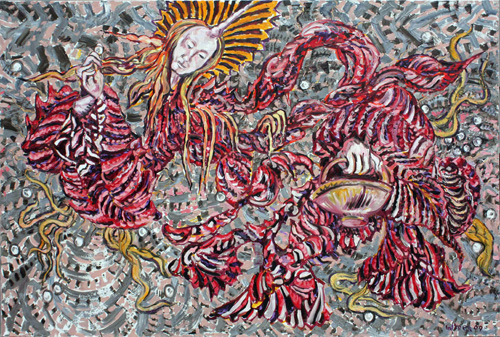
George Gittoes. The Collector, 2009–2010. Oil on canvas, 200 cm x 300 cm.
The Australian art historian, Bernard Smith who taught George Gittoes at the University of Sydney in 1968 included him (as the only Australian) in his book Modernism’s History (1998)12 as an international extension of Neue Sachlichkeit (New Objectivity) of the tradition of artists such as Max Beckmann, Otto Dix, George Grosz and John Heartfield. Since the 1960s Gittoes has produced paintings, drawings, photographs and films in conflict zones including: Cambodia, Israel, Palestine, Afghanistan, Iraq, Mozambique and Zimbabwe. His most recent film is The Miscreants of Taliwood (Produced by Gabrielle Dalton) for which he travelled to the heart of the tribal belt in Peshawar, Pakistan. Shocking excerpts from Taliban propaganda are included in Miscreants which had its US premiere in September 2009 at the Telluride Film Festival in Colorado, followed by showings at the Museum of Modern Art, New York in February this year, as well as European showings in Amsterdam and Basle. The message in Miscreants, as in all of George Gittoes work, is strongly anti-war.
Gittoes response is always personal; he befriends his “subjects”, many of whom are experiencing acute trauma, drawing the injured and dying which he says is always comforting for the victim – the process of being drawn whilst comforted in the final stage of life, ensures an image of them will live on.13 Gittoes tends the victims of war in selfless and risky positions repeatedly. The immediacy of the drawn image is Gittoes’ most incisive language and through it he seeks to reveal inner lives, psychological conflict as well as making a record of the actual conflict of war. His work is firmly rooted in the tradition of Albrecht Dürer, Francisco Goya, Mathias Grünewald, El Greco, Max Beckmann, Otto Dix.
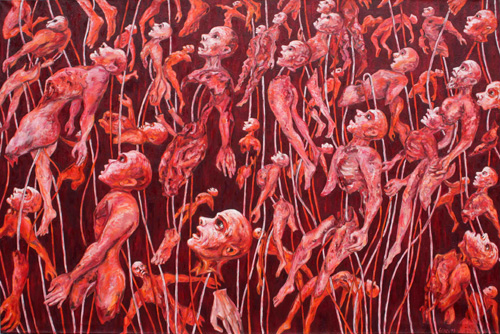
George Gittoes. Assumption, 2009–2010. Oil on canvas, 200 cm x 300 cm.
Gittoes incorporates aspects of technology and media such as the fish eye lens perspective, cartoon imagery and graffiti, establishing a potent contemporary message,14 and separating him stylistically from Kiefer or Baselitz. Over the years his drawn line has become more quickly applied, more certain. Aware of the shifts that have taken place, in mass media, in film, in the dissemination of information through non-traditional channels, Gittoes has adapted his documentary methods accordingly. The most terrible realities of our age are used, not to moralise but as an urgent message to appeal to our better judgement. The skulls of suicide bombers are metamorphosed into fantastic and hideous creatures, insects and monsters. He seeks to create images not of the paradise the suicide bombers aspire to, but a Hell or Limbo – a situation very much worse than physical death. Gittoes witnessed at first-hand, Saddam Hussein’s “Reign of Blood” – bodies dead in the streets and prisoners tortured.15 The Descendence series uses text and painting to emphasise the hellish limbo of death in war, the destruction of the human soul.
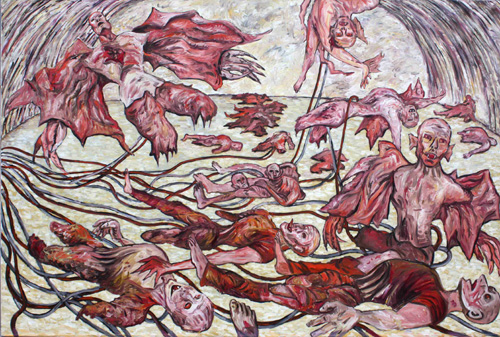
George Gittoes. Descendence, 2009–2010. Oil on canvas, 200 cm x 300 cm.
In Berlin Christiana Spens interviewed George Gittoes for Studio International whilst viewing the exhibition. There the Descendence series of paintings were hung as an installation, which the viewer experiences as like walking through a graphic novel. When Aquarium Blood is staged in Houston (2011), the viewers will be given a comic book produced by the artist from his drawings, paintings and stories. The images in the exhibition will form the basis of the comic book, where stories accompany the drawings – both the Berlin works as well as a body of work that will be executed in Texas. A music style CD with the artist performing the stories will be produced, incorporating the music of Mitch Harris from English heavy metal band, Napalm Death. Gittoes explained the processes involved to Spens:
Normally in war zones, I draw and write in the diaries … And the reason I come to somewhere like Germany, is to do the paintings and make up the installation of it. So if we look at these diaries, these were done in Afghanistan and Iraq – all these works evolved in the field. And then the time in the studio like this is the time to do these large works inspired by the stories written in the field. In fact, using digital technology, most of the work with Napalm Death can be done while I’m in Afghanistan, so I’ll record… and send them the stories and they’ll be creating the music for it. And they’ll have recordings of gunfire and so on in the background, and dialogue with soldiers, and they’ll probably use that in the music.16
The stories as they are presented by the artist – in painted text on the canvases, or in their eventual form as text for the comic book, are written after the paintings are complete. The research process is a continual one, where material is gathered in an anecdotal form in diaries, in the war zones, most recently Iraq and Afghanistan, and expanded and polished after the paintings are made. Joanna Mendelsohn who has known Gittoes since they were at school together, explains his working method:
The best way of describing Gittoes’ approach to all his art is that he layers and accumulates images and ideas until, out of apparent chaos, there is a synthesis of idea, passion and image. His love of Islamic cultures, especially the Sufi poets, a love nurtured since he was a schoolboy, and his talent for drifting away from where westerners choose to go, places Gittoes’ adventures in the tradition as older European adventurers. He changes into the clothing of the country where he is travelling, picks up enough patois to get by, and draws. In places and circumstances where life can change into death in an instant, someone with a camera can be vulnerable. Photographers in war zones are usually outsiders, often exploiting the pain of victims of war. But the intimate act of drawing is less threatening, especially as Gittoes is not afraid to expose himself through art. “An artist actually exposes their own inner life whereas a journalist doesn't,” Gittoes says. The act of making shapes and lines, leads to dialogue.17
Each of the paintings in the Descendence Series has a text panel to accompany it, creating a series of diptychs. The stories have been written by Gittoes after completing the paintings. All of the ideas – visual and literary – are inspired by episodes and events in war zones, and the nature of 21st-century warfare. Conceived in diary form in Iraq and Afghanistan, and painted on 200 mm x 260 mm canvases in Berlin, they bring together diverse aspects of Gittoes working methods over the past 40 years in film, drawing, puppet making and theatre, music and painting. The diaries represent a laboratory of ideas; for a mostly itinerant artist they are his portable studio. The Descendence Stories by George Gittoes tells the story of the Virus Squad led by Corporal Night, which attacks a peaceful farmyard with a remit to kill, and where the soldiers are eaten by a spider.
He has led his men into a kill zone – they crumple and hit the ground around him.
His own chest explodes. Night is down. He thinks: So it is over at last, an end, oblivion, peace.
He is falling through a fissure in a volcano, red streaks flash by.
The air burns.
He bounces, caught in some sticky threads. His chest pounds but he knows he must be dead: Why do I still feel pain?
His eyes blur into focus on a monstrous creature: Is this the Devil ? -
It moves towards him.
He is stung and eaten.Inside the spider is a jelly like existence.
He finds he can squirm his way through its flesh.
He comes up against two other members of his troop.
But inside the spider it is each man for himself.18
Atmospheric snapshots and nightmarish scenarios are presented where soldiers experience worse than death scenarios. Gittoes explores physical and spiritual death, altered states of consciousness, drawing on imagery from dreams and horror movies. Presenting particularly vile episodes, with a science fiction style range of gruesome fates, Gittoes presents the futility of war throughout history to show the repetition of horror.
In Descendence Hangar, the mangled bodies of the Virus Squad are dead but conscious of their surroundings. They realise they are inside a science experiment and that, “Physical death is nothing compared to what our enemy can cause”. Metamorphosis uses a sexually impotent insect body to describe the vile journey where inescapable guilt torments the accused. Night, the perpetrator of war crime, sees his life rush before him. He desperately wants to be reunited with his family. Aspects of the artist’s autobiography are referenced – his son with his surf board and his daughter with her horse; his wife, preoccupied and juggling aspects of life, a sad image of the artist who has sacrificed normal family life to what is tantamount to a religious calling. The fear in war zones is given powerful vent here, the inevitable feeling that he might never see his own family again filters into the psyche of the soldiers who confront death daily.
In Zombie Shuffle, Gittoes questions modern media, making particular reference to the mind-numbing capacity of propaganda and the urgent necessity for independent media. The Living Dead describes the eleventh day of a twelve-day mission, where the Taliban materialised for a Wild West style shoot out; there were no survivors on either side:
Face down in the sand Night knew he was fully dead as a clean up crew arrived but he was still fully aware of all that was going on around him.
The guys got out of their vehicles and Night thought “good, soon I will be in a pine box and a big transport will be taking us home. Finally rest, peace. This is not going to be too bad “ and he began to believe the afterlife could prove to be half decent.
Their bodies were rolled over, all identification stripped from them and the weapons collected, then the vehicles left. That was it, no trip home, nothing! They were going to be left to rot with their enemies, food for the birds.
It was rumored the coffins were stuffed with high-grade heroin for US addicts. Night realized: ”without bodies there is more room for the smack.”
Gittoes exposes the cynicism of governments, the ad hoc nature of scientific research in the name of warfare, the deep injury to mind and body:
The army had been using them as guinea pigs to test all kind of broad based antibiotics and regenerative drugs to make wounds heal fast. “Was this an unwanted side effect or the Day of Resurrection?”
Speech was impossible but Night still had the will to lead. He lifted one heavy foot in front of the other and started their march through the sand.
It is not easy being a zombie – the atmosphere feels a lot thicker, like being a hundred meters underwater – every limb is weighed down by pressure from above. Moving forward is half like swimming. Night found he had to paddle the air to drag himself forward, making his hands work like flippers.
No rest, no R & R and no forgiveness.
Trauma and memory-loss are confused with time travel. The senselessness of history repeating itself is conjured in Gittoes’ text and images by the use of a building that occurs over and over, reappearing in Ancient Rome, Medieval Europe, and the Somme. Scenes from escapist propaganda confuse the present, where Night plaintively asserts, “I am from the 21st century!” Death comes finally with a flashback to a Latin class and the realisation that the dream, the narrative is peopled from characters from Classical mythology: Cerberus, Charon, set against the River Styx, which signifies death. No respite, no peace, for in the final episode of Descendence, George Gittoes uses Crash Dummies; the robots with which the army trains soldiers in first aid, are used to represent the tortuous journey where soldiers die repeatedly in spiritual terms, the cruel and sinister attitudes in wartime that deem life expendable. Horror movie imagery is employed by Gittoes to represent the madness of war. Science fiction is used to great effect:
Restart has been pressed, and Night jerks back into life with a ringing in his skull and harsh voltage spiking every joint of his badly abused body.
He cannot remember how many times he has died and been brought back. There is scar tissue on his scar tissue and the wounds never stop hurting.
The trip from death into the afterlife and back is torture.
Virus squad were on their way home, for well earned leave, when their chopper was hit by a rocket. They were kept breathing by paramedics flying in a chopper in the same formation. Their bodies were beyond repair but the Kevlar helmets protected their skulls well enough for doctors to remove their brains.
The use of Night’s brain and those of the rest of his Virus Troop is classified. Technology still has not developed anything as sophisticated to register pain and trauma as the human brain. Night believes they are the first stage in an experiment to produce cyber soldiers.
The dummies are completely robotic and could stand up and walk around if allowed to. The trainee soldiers who come to learn from them all comment on how eerily alive they seem.
The power of Descendence Stories derives from Gittoes film-making achievements, and drawing. The drawings in diary form are imbued with the belief that art is of paramount value in society as a means of communicating and understanding the most threatening and dreadful aspects of life. Gittoes’ diaries inform and underpin all of his work and in those it is possible to identify many aspects of his thought processes as he attempts to process the madness of war, the cruel and dreadful events such as the murder of Margaret Hassan on 17 November 2004, and to whom his exhibition in 2004 was dedicated. Fear.com, (2002) shows the distorted image of a head with the collaged newspaper report, “Iraq Terrror Bids: UN report includes plans for dirty bombs, nerve gas”. The impact of such rhetoric was used to fill the minds of citizens around the world with fear, and to justify the US invasion of Iraq. The emotional and psychological dramas are revealed by Gittoes, his powers of identification rare and poignant. It is only in drawing that Gittoes can express his heartfelt indignation against war, and in Descendence he has adapted the fluidity of line and idea, to powerful effect. The drawings incorporate the visual devices of Goya whose witches in trees, satanic flying vampires expose the extremes of human violence in the darkest supernatural forms. The dynamism of his images is informed by a wide range of influences, from surrealism to the history of caricature, black humour, and an unerring eye for detail. The immediacy of the drawn line enhances the message, providing images that are haunting and with a lasting impact. Gittoes’ apocalyptic visions have the rare ability to be noticed amid the barrage of media forms, to reach to the heart of the matter. He was in Afghanistan when 9/11 occurred. He went to New York and experienced the haunted aftermath of the destruction of the Twin Towers. The drawings Red Dragon and Fear.com capture the aftermath of the mass killings. The titles refer to films that were being shown, at the time, in effect a means of fixing the atrocity to the “cultural moment”. Gothic art in a contemporary context links to the high art tradition of Matthias Grünewald and Hieronymous Bosch.19
References
1. www.stationmuseum.com
2. George Gittoes, Interviewed by The National, 02 April 2010.
3. Michael Auping (ed), Anselm Kiefer: Heaven and Earth, London, Prestel, 2005, p.27.
4. Ibid, p.48.
5. Ibid, p. 34.
6. George Gittoes, Email to Janet McKenzie, 30 March 2010.
7. Mayen Beckmann, “This is why you were born”, unpublished essay, 2008.
8. Max Beckmann, quoted ibid.
9. Ibid.
10. George Gittoes, interview with Janet McKenzie, June 2009.
11. Ibid.
12. Bernard Smith, Modernism's History: A Study in Twentieth-Century Art and Ideas, University of New South Wales Press, Sydney, 1998.
13. Gittoes, interview with Janet McKenzie June 2009.
14. Mayen Beckmann, op.cit.
15. Joanna Mendelssohn, George Gittoes: No Exit, Australian Galleries, Sydney, 15 February – 4 March 2007
16. George Gittoes interviewed by Christiana Spens, Berlin, 23 March 2010.
17. Joanna Mendelssohn, “George Gittoes: Art, War and Videoclips”, unpublished essay, 2008.
18. Extract from George Gittoes, unpublished DESCENDENCE STORIES. From NIGHT VISION, the diaries.(2009) All following extracts, ibid.
19. Russell Storer, “Truth be told: George Gittoes”, unpublished essay, 2008.